
by Erik Lovestrand | Aug 25, 2017
Many species of animals go through dramatic swings in population numbers over time. For some, these fluctuations are related to the dynamics of a natural symbiotic connection such as a predator-prey relationship. A classic example of this is the famous snowshoe hare/lynx model taught to all wildlife ecology students. The lynx numbers follow the hare numbers with a lag in the population upswings and downswings. For other species, it may simply be related to changing environmental conditions that they either do not tolerate well or that they thrive in. This is primarily the case with our panhandle bay scallop populations from year to year. During the time I’ve lived in North Florida I’ve experienced both ends of the spectrum during local scallop seasons. Some years, you can limit-out as fast as you can pluck them from the sea grass bed. Other times, the old adage of “finding a needle in a haystack” comes to mind. Over the past few years we have experienced some of these dramatic swings for various reasons.
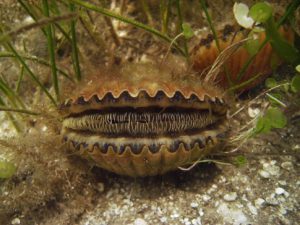
Bay Scallop Argopecten iradians
Bay scallops are mostly an annual species, with spawning taking place as water temperatures drop quickly during fall cold fronts. Harvest numbers the following summer are a result of larvae that matured in a single season. Occasionally, you will find an old “mossy-back” that is significantly larger and likely a holdover from the previous season. During spawning, a single scallop can release millions of eggs but very few survive to adulthood and throughout their brief lifespan they are susceptible to many mortality factors.
Predation by crabs, sea stars and several species of marine snails takes a toll but is generally not the driving force in significant declines.
One factor that does have population-level impacts is the amount of rainfall locally. Too much freshwater will create physiological stress and kill scallops over large areas. They can also be hammered by extreme heat or cold events due to their nature of inhabiting relatively shallow coastal waters. Other population pressures may not be so obvious because they sneak up on scallops gradually rather than happening all of a sudden. Factors such as propeller scarring in seagrass beds and siltation from terrestrial runoff or human activities, can have a cumulative effect that gradually degrades the seagrass habitat where scallops live. Another factor that can cause near-extinction of local populations is the occurrence of harmful algal blooms such as red tide. The toxins produced by these marine dinoflagellates will kill fish, marine mammals and shellfish alike. This is what happened to the scallops in St. Joseph Bay during the fall of 2015 when a red tide bloom killed most of the spawning population.
A more recent event in St. Joseph Bay, that put a damper on the 2017 season, was a bloom of a different marine dinoflagellate species known as Pseudo-nitzschia. This organism can produce a toxin known as domoic acid which can cause amnesic shellfish poisoning in humans. Thankfully, it is not expected to harm the shellfish themselves and next season may be a real bumper year. That is, if everything else that can go wrong for a scallop decides to give them a bit of a break. When environmental conditions are good, it is astounding what Mother Nature will provide. Put on your snorkel gear and check it out! For information on seasons and more detailed biology visit the Fish and Wildlife Research Institute’s webpage here. For some tasty recipes check out the Fresh From Florida page here.
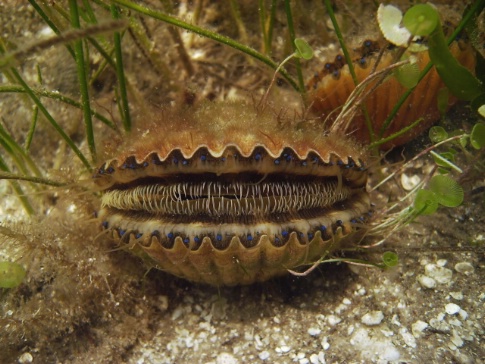
by Rick O'Connor | Aug 26, 2016
MAN do folks in the Florida panhandle like scallops. I recently visited boat ramps at Steinhatchee and Keaton Beach (in the Big Bend) and the parking lots were full of trucks and boat trailers belonging to people combing the grassbeds of the Gulf searching for this popular bivalve. Scalloping is a fun activity that gets the whole family outside snorkeling and finding all sorts of local marine life. And scallops taste good… their sweet meat broiled in butter is a real Florida panhandle treat. Many locals remember years ago collecting scallops with family and friends in Pensacola Bay area …. Good times!

Bay Scallop Argopecten iradians
http://myfwc.com/fishing/saltwater/recreational/bay-scallops/
But that was another time. Scallop populations have declined across Florida’s Gulf coast. Today commercial harvesting is banned and recreational harvest is limited to the Big Bend area between the Bay/Gulf and the Hernando/Pasco county lines (visit map). Within this area there is a seasonal limit, bag limit, and harvesting equipment limits. The season runs from Jun 25 – Sep 24 (except in Gulf County). Harvesters can collect 2 gallons whole (or 1 pint cleaned) / person / day. There is a maximum of 10 gallons whole / vessel / day. You can collect by hand or using a dip net. All harvesters are required to have a Florida saltwater fishing license unless (a) they are exempt from such a license, or (b) they are wading nearshore and their feet do not leave the bottom (no swimming or snorkeling). For 2016 the regulations for Gulf County have changed, please visit the above link at FWC for those changes. BUT wouldn’t it be great to be able to scallop in the Pensacola Bay area again?
County Extension Sea Grant Agents have been working with the Florida Fish and Wildlife Conservation Commission surveying Gulf coast bays that once had scallop populations – including Pensacola Bay. The purpose is to determine the status of these animals at the moment. Scallops are mass spawners and need a relatively high density of individuals in order for reproduction to be successful. The state could easily “re-seed” these areas with scallops to increase the density but their populations declined for a reason. Was it water quality? Loss of habitat? Heavy predation (human or marine life)? Or a combination? We are not sure… but a re-seeding project will not be successful until it can be determined that the stresses that caused the reduction have improved enough that the scallop will survive.
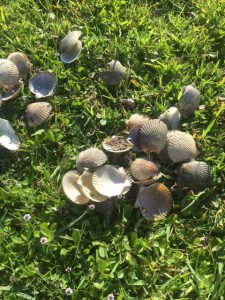
A pile of cleaned scallops found in a parking lot on Pensacola Bay. Harvesting scallop in Pensacola Bay is illegal.
Photo: Rick O’Connor
On that note, Santa Rosa and Escambia County Extension Sea Grant Agents recently held two scallop surveys; one in Santa Rosa Sound and one in Big Lagoon. The morning of our Santa Rosa Sound survey we found a pile of cleaned scallops in the parking lot of Shoreline Park (approximately 35 scallops). This is a good sign in that it suggests scallops are trying to make a comeback here. It is bad in that they were harvested. Many in our community are not aware that harvesting scallops in Pensacola Bay is illegal. No recreational or commercial harvest of bay scallop is allowed, even during scallop season, west of the Gulf County/Bay County line (Mexico Beach). If you are out paddling around our grass beds and find live scallop please let your county Sea Grant Agent know, but also remember that you are not allowed to harvest them. Hopefully one day we will be able to tell you that yes you can, but until then we need to give them a chance to spawn and see if our grassbeds, and water quality, are sufficient enough for them to return.
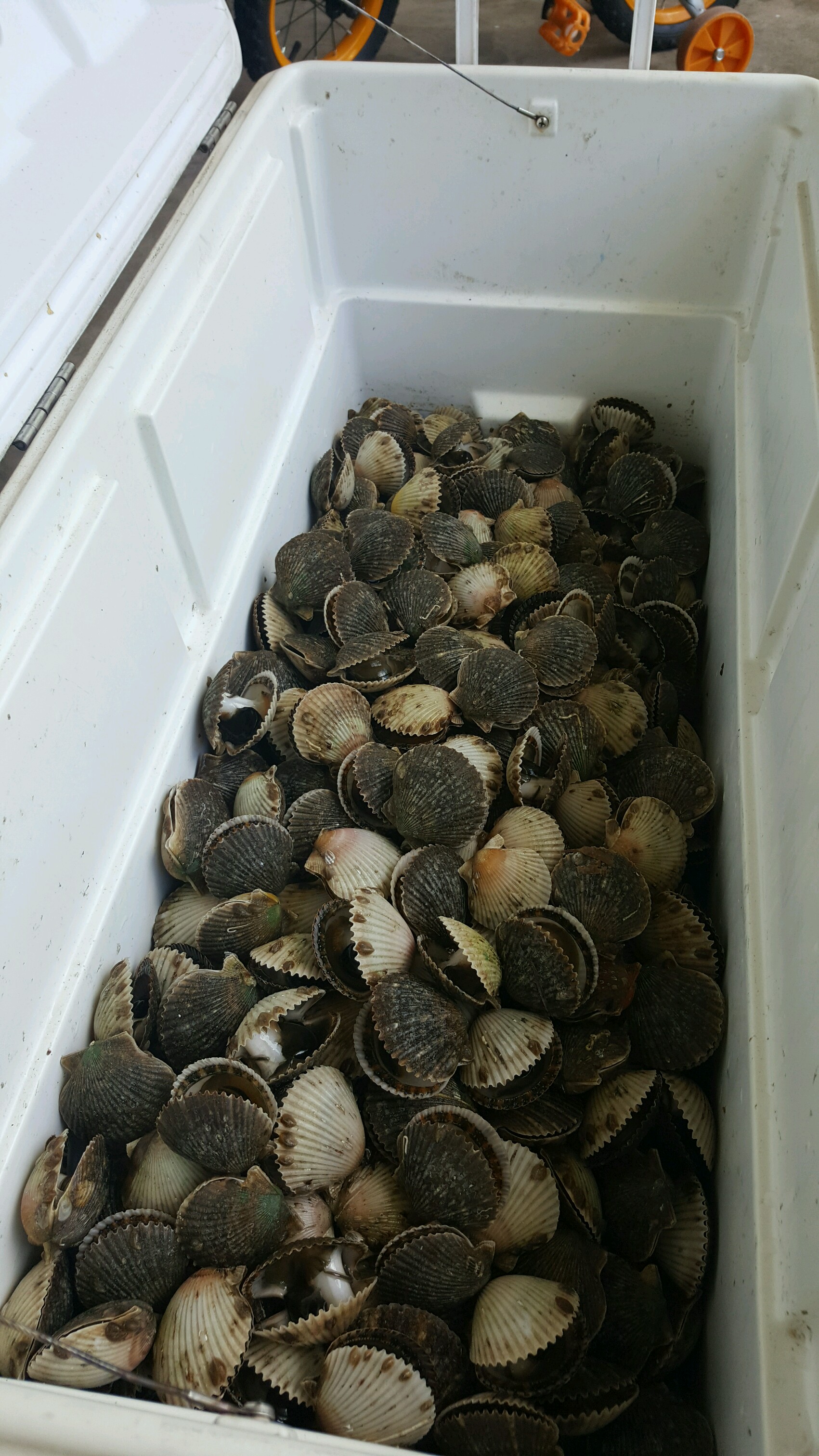
by Erik Lovestrand | Jul 31, 2016
If you have done this phenomenal summertime activity, then you know what I’m talking about. And it’s not just the kids that derive an amazing, nature-based educational experience. Anyone who puts on a mask and snorkel for their first scalloping adventure is about to have their world “rocked” in a good way. Gliding over the shallow seagrass meadows where these bivalves live will produce a sensory experience of sights and sounds like never before.
Florida’s bay scallop (Argopecten irradians), is a mollusk with a well-deserved reputation for being fun to harvest and scrumptious on the dinner plate. However, before you hit the water, there are a few things to consider that will make your scalloping experience safe, enjoyable and educational. Information provided in this article should give you the basics and hopefully encourage you to participate in this Florida Bigbend/Panhandle area’s best reality-show ever!
Know Before You Go: The Florida Fish and Wildlife Conservation Commission governs the rules regarding scalloping zones, license requirements, harvest limits, seasons, gear requirements, and boating laws. For detailed information visit the FWC website on the topic. Take time to review this information so that you are safe and legal when on the water.
Finding the Critters: As always, it is best to know someone who has already been out and can point you to a good location. Barring that scenario, simply search the internet or Facebook, or call the local dive shop or bait and tackle store that sells gear. People are generally very kind in this regard and will at least get you close to the right spots. When you get close, just look for where the boats are gathered. Don’t waste your time trying to find a secluded spot of your own because those boats are there for a good reason. Move at an idle speed and be very careful approaching other vessels. You should be looking for swimmers at all times as some will stray far from their anchored boat with the dive flag displayed. Legally, you are supposed to stay 300 feet from a displayed diver down flag in open waters.
Boat Safe and Smart: The shallow nature of most scallop habitat requires that you understand tidal cycles in the area where you are boating. It is not at all pleasant to be stranded and waiting for the next high tide before you can go home with your catch. In addition to the inconvenience, there are other more serious consequences that may occur in this situation. Often, boaters will realize too late that they have been caught by low water and, whether out of fear or ignorance, start up the motor and attempt to leave in a hurry. This can result in a dangerous grounding at high speed, damage to the vessel or motor, and serious propeller scarring in the very seagrass beds that support the scallops and a host of other amazing species. Best bet, if you can’t put your motor down without it being in the grass, attempt to wade it out to deeper water before starting the motor.
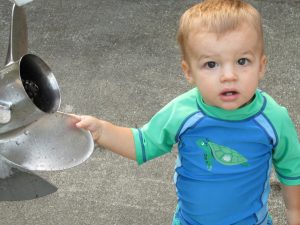
Safety check on equipment before leaving…
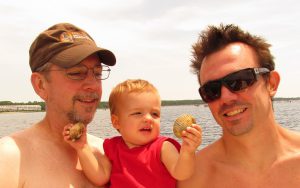
…Often leads to a successful adventure!
Keeping the Catch: If you are not shucking your scallops right on the boat as they are caught you need to protect them for the trip home. The safest way is to place your live scallops on ice in a cooler under shade. When cleaning the catch, it is handy to have a bowl with some ice water handy to drop the meats into for quick chilling. This also keeps them plump and moist for cooking. An old butter knife with a slight bend at the tip works well for shucking and many people even use a spoon if they don’t already have an official scallop knife. Check out this Florida Sea Grant scallop brochure for a couple of tasty recipes for after the shucking is done.
In the end, you are ultimately responsible for whether or not you have a safe, enjoyable experience. So, follow the rules, watch the weather, know the waters where you boat, and have the time of your life. Oh, and take a kid or two along for the comic relief. When you see them surface, squealing with joy at the first bay scallop of their life, I guarantee everyone will be smiling.







